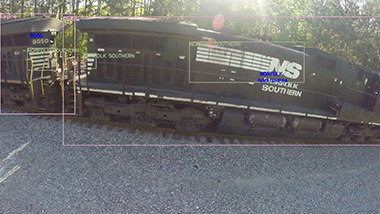Yard Locomotive Detection System Development

Ming-Ching Chang received an award from General Electric Global Research of $200,000 to fund his project titled “Yard Locomotive Detection System Development.” Collaborating with GE Research, GE Transportation, and CSX Transportation in a real world local railyard setting, Chang is using Artificial Intelligence (AI) and Internet of Things (IoT) to improve railyard management.

The rail yard is a complex series of railroad tracks for sorting and organizing railroad cars and locomotives. Each railcar has a unique serial number, much like an automotive license plate. Each serial number is located in a different location, depending on the kind of locomotive (e.g., box car, gondola car, hopper cars, etc.).

This sorting operation currently requires humans to visually identify the incoming locomotives, then classify and rearrange them using switchers. The goal of this project is to automate the entire sorting process. This automated switching operation will speed up the railcar sorting and move them out of the station in a shorter time span. The first step towards such automation is to detect, recognize and classify each railcar, and recognize any serial texts/numbers, or logos on each railcar.
To achieve effective site-wide tracking of railcars, Professor Chang and his team will deploy several cameras at each entrance of the rail yard. Using these cameras, the team will develop algorithms to automatically identify the serial numbers and types of each railcar. Video analytic algorithms will be developed and deployed at IoT edge devices e.g. the NVIDIA Jetson Xavier boards. Recognized railcar information will be transmitted to the control center via message passing. The developed systems and framework will be deployed and evaluated at the CSX Selkirk Yard. Expertise and feedback from the customers (CSX Transportation) will be used to improve algorithm and system design.

Ming-Ching Chang is an assistant professor of Computer Science. His expertise includes video analytics, computer vision, and machine intelligence. After graduating from Brown University with a PhD, he worked as a computer scientist in the Computer Vision Lab of GE Global Research, where he was a member of the distinguished Visualization and Computer Vision (VCV) Group. Dr. Chang has worked on major external government programs, including the Defense Advanced Research Projects Agency. He was also a Co-Principal Investigator for a series of programs awarded by the National Institute of Justice which focused on developing a group behavior recognition system that operates in unconstrained environments.


